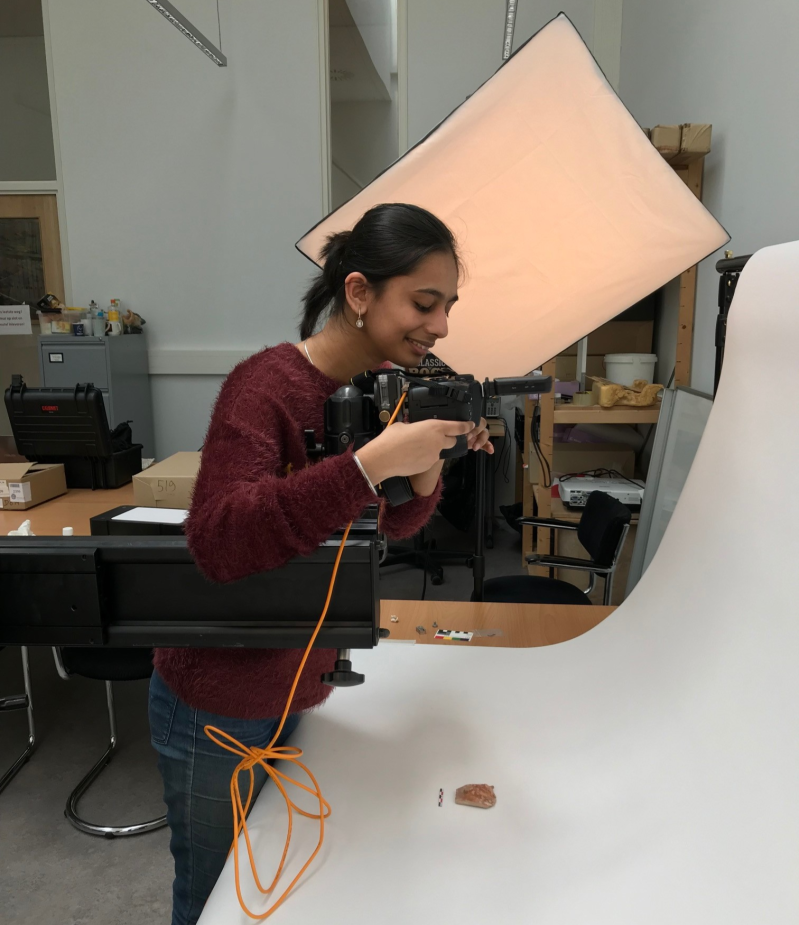
Rishika Dhumal has just finished her Master’s at Leiden University, and is now preparing to continue her research as a PhD . This summer, she went back home to India, but not just to see her family! Preparing for a PhD is not something you easily forget about, not even when leaving the Netherlands for a well-earned break in India. So, Rishika also visited her old university in Baroda, the Maharaja Sayajirao University, where she was granted access to the depot of the archaeological department.
Her research looks into the Indian subcontinent’s role in Afro-Eurasian trade networks of the early first millennium CE . Specifically, she studies the pottery and beads from sites in Gujarat (a state on the West coast of India) and from Anuradhapura, Sri Lanka. Through these materials, she hopes to trace ancient trade networks across the Indian Subcontinent. It is remarkable that there seem to be many more objects found in the south, for example at the famous site Arikamedu (near Pondicherry), than at sites in Gujarat. Rishika is finding ways to explain this phenomenon. For this reason, she mentioned she wants to analyse anchors - again from both regions - to see what type of ship transported what type of good. A lot of anchors are found in the sea and she even knows of a manufacturing sites in Gujarat.

Luckily for her, almost all excavations in Gujarat are executed by the University of Baroda (MSU) and the state department of Archaeology, ASI (Archaeological Survey India). Most objects and all the relevant excavation reports are stored in the university’s depot.
This time around, Rishika was only able to spend one week among the remarkable objects in the depot, as a first exploration. One week was enough to make some meaningful connections, however. She met an old classmate who is now also doing a PhD. He was researching a type of pottery found also at one of the sites Rishika will be investigating. This may be the start of a collaboration and it may even be possible that they will be excavating together at the same site in January. This would be an excavation at Nani Rayan, so far only known from historical texts. Trial trenches have already been dug, and the material is very promising (Rishika’s face lit up with enthusiasm as soon as this came up!)
She casually mentioned that the excavation would be in January, because that is really the only time any fieldwork is done in India. I was not surprised at first - Leiden University organises lots of digs in January too - but I still asked her to elaborate. She then told me it is simply not allowed to do fieldwork in most other months, because of the heat. So I wondered, is it truly forbidden? ‘Yes,’ she explained, ‘because all excavation permits are given by ASI and they do not give them if you are planning fieldwork in the hot months for fear of archaeologists dropping dead.’ Apparently, our scholarly physique cannot be trusted in high temperatures. Fair enough, though, as temperatures of 45 degrees Celsius (or higher) would be taxing for anyone, especially while digging trenches…
She also reconnected with one of her former professors, who heard of Leiden University’s ceramics depot and suggests that some material may indeed be from India. For that reason, our team is planning to work together and do a comparative analysis of the objects from both depots. During her Master’s in Leiden, Rishika has helped start up a new inventory of the Leiden pottery depot, so she already has hands-on experience with the ceramics kept there. Her internship at the Leiden depot included a lot of counting and filling out forms to document all the boxes and sherds – sometimes a painstaking job to do, in a large depot without any windows! But her hard work has already led to a new study about Indian pottery at various Silk Roads sites in the Near East, which Rishika will co-author later on in the year.
As you can see: lots of interesting cases lie ahead for our project!

Add comment
Comments